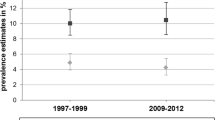Abstract
Background
In contrast to the huge number of prevalence studies, there are relatively few incidence studies of depressive disorders. Furthermore, estimates of incidence vary remarkably between existing studies. The aim of this paper is to add knowledge about the incidence and determinants of depressive disorder, based on the Finnish sub-sample of the European Outcomes of Depression International Network study.
Method
The random population sample in the Finnish sub-study consisted of 2,999 subjects, aged 18–64, selected from one urban and one rural area. In the baseline survey, potential cases of depressive disorder were identified using the Beck Depression Inventory. SCAN-2 interview was used to assign caseness against ICD-10 criteria. Findings from the 1-year follow-up survey with those who responded in the baseline survey (N=1,939), using the same case-finding instruments, were used to estimate the incidence rate of depressive disorder.
Results
The estimated annual incidence rate for all depressive disorders, including both first-time and recurrent episodes, was 28.5 per 1,000; for first-time episodes it was 20.5 per 1,000. Significant predictors for experiencing a depressive episode were: suffering from self-perceived long-term illness or handicap, experiencing little or no concern from friends, low sense of coherence, low self-confidence, uncertainty about one's future and reporting two or more threatening life events during the preceding 6 months.
Conclusions
About 3% of the working-age population experience an episode of depressive disorder each year. Due to recall problems, the estimate of first-time incidence may be too high.

Similar content being viewed by others
References
Antonovsky A (1993) The structure and properties of the sense of coherence scale. Soc Sci Med 36:725–733
Ayuso-Mateos JL, Vázquez-Barquero JL, Dowrick C et al (2001) Depressive disorder in Europe: prevalence figures from the ODIN Study. Br J Psychiatry 179:308–316
Beck AT, Ward CH, Mendelson M et al (1961) An inventory for measuring depression. Arch Gen Psychiatry 4:561–571
Bijl RV, de Graaf R, Ravelli A et al (2002) Gender and age-specific first incidence of DSM-III-R psychiatric disorders in the general population. Results from the Netherlands Mental Health Survey and Incidence Study (NEMESIS). Soc Psychiatry Psychiatr Epidemiol 37:372–379
Brevik JI, Dalgrad OS (1996) The Oslo Health Profile Inventory. University of Oslo, Oslo
Brugha T, Bebbington P, Tennant C et al (1985) The list of threatening experiences: a subset of 12 life event categories with considerable long-term contextual threat. Psychol Med 15:194–198
Dowrick C, Casey P, Dalgard O et al (1998) Outcomes of Depression International Network (ODIN). Background, methods and field trials. Br J Psychiatry 172:359–363
Dowrick C, Vázquez-Barquero JL, Wilkinson G et al (1999) Organizing ODIN: a case study in European academic co-operation. Eur Psychiatr 14:177–181
Eaton WW, Anthony JC, Gallo J et al (1997) Natural history of Diagnostic Interview Schedule/DSM-IV major depression. The Baltimore Epidemiologic Catchment Area follow-up. Arch Gen Psychiatry 54:993–999
Eaton WW, Kramer M, Anthony JC et al (1989) The incidence of specific DIS/DSM-III mental disorders: data from the NIMH Epidemiologic Catchment Area Program. Acta Psychiatr Scand 79:163–178
Hagnell O, Lanke J, Rorsman B, Öjesjö L (1982) Are we entering an age of melancholy? Depressive illnesses in a prospective epidemiological study over 25 years: the Lundby Study, Sweden. Psychol Med 12:279–289
Lehtinen V, Veijola J, Lindholm T et al (1996) Incidence of mental disorders in the Finnish UKKI Study. Br J Psychiatry 168:672–678
Murphy JM (1996) Incidence of mental disorder. Letter to the editor. Br J Psychiatry 169:667–668
Murphy JM, Monson RR, Sobol AM, Leighton AH (2001) Studying the incidence of depression: an ‘interval’ effect. Int J Methods Psychiatr Res 9:184–192
Murphy JM, Olivier DC, Monson RR et al (1988) Incidence of depression and anxiety: the Stirling County Study. Am J Publ Health 78:534–540
Murphy JM, Olivier DC, Monson RR et al (1991) Depression and anxiety in relation to social status. Arch Gen Psychiatry 48:223–229
Oldehinkel AJ, Wittchen HU, Schuster P (1999) Prevalence, 20-month incidence and outcome of unipolar depressive disorders in a community sample of adolescents. Psychol Med 29:655–668
Patten SB (2003) Recall bias and major depression lifetime prevalence. Soc Psychiatry Psychiatr Epidemiol 38:290–296
Pulkkinen L, Rönkä A (1994) Personal control over development, identity formation and future orientation as components of life orientation: a development approach. Dev Psychol 30:260–271
Romans SE, Walton VA, McNoe B et al (1993) Otago Women's Health Survey 30-month follow-up. I: onset patterns of non-psychotic psychiatric disorder. Br J Psychiatry 163:733–738
Rorsman B, Gräsbeck A, Hagnell O et al (1990) A prospective study of first-incidence depression. The Lundby Study, 1957–72. Br J Psychiatry 156:336–342
Sandanger I, Nygård JF, Ingebrigtsen G et al (1999) Prevalence, incidence and age at onset of psychiatric disorders in Norway. Soc Psychiatry Psychiatr Epidemiol 34:570–579
Surtees PG, Sashidharan SP, Dean C (1986) Affective disorder amongst women in the general population: a longitudinal study. Br J Psychiatry 148:176–186
Thompson R, Bogner HR, Coyne JC et al (2004) Personal characteristics associated with consistency of recall depressed or anhedonic mood in the 13-year follow-up of the Baltimore Epidemiologic Catchment Area survey. Acta Psychiatr Scand 109:345–354
Wittchen HU, Essau CA, von Zerssen D et al (1992) Lifetime and six month prevalence of mental disorders in the Munich follow-up study. Eur Arch Psychiatry Clin Neurosci 241:247–258
World Health Organization (1994) Schedule for clinical assessment in neuropsychiatry: version 2.0. WHO, Geneva
Acknowledgements
ODIN has received financial support from the European Commission Biomed 2 Programme (Contract BMH-4-CT96-1681). The Finnish sub-study has been supported by grants from the Finnish Pensions Institute of Agricultural Entrepreneurs (Contract 0339) and the University Central Hospital of Turku.
Author information
Authors and Affiliations
Corresponding author
Rights and permissions
About this article
Cite this article
Lehtinen, V., Sohlman, B., Nummelin, T. et al. The estimated incidence of depressive disorder and its determinants in the Finnish ODIN sample. Soc Psychiat Epidemiol 40, 778–784 (2005). https://doi.org/10.1007/s00127-005-0956-4
Accepted:
Published:
Issue Date:
DOI: https://doi.org/10.1007/s00127-005-0956-4



